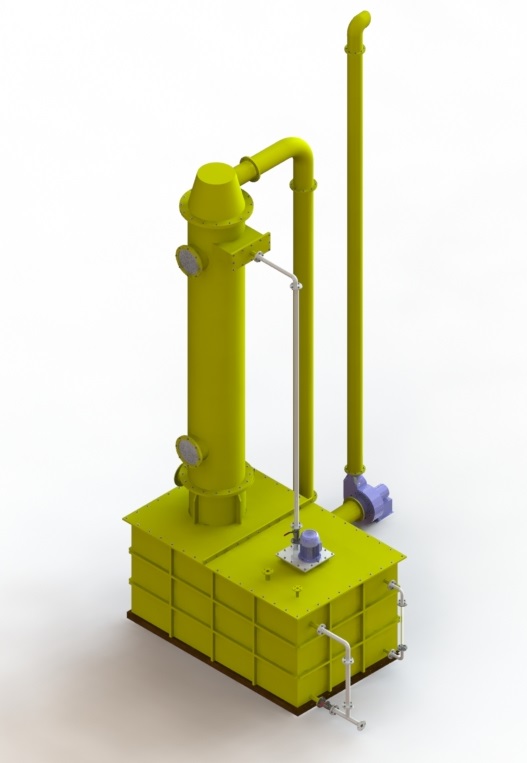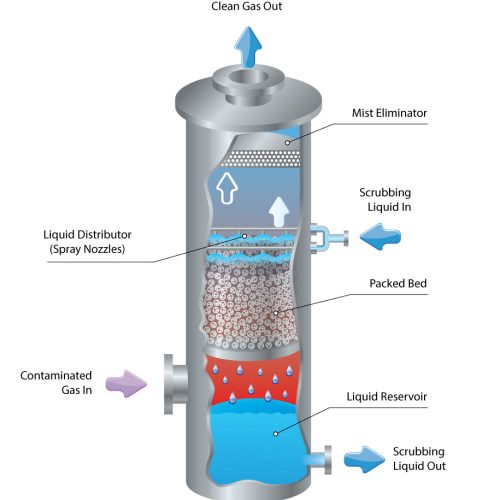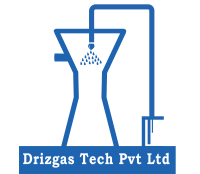Features
- Can handle air flow rate from 100 to 30,000 CFM
- Removal method is Absorption / Chemisorption
- Material of Construction: PP, FRP, PP+FRP, MS+FRP, SS 304, SS 316
- High efficiency Tellerette®Tower Packing removes soluble/reactive gases, solid particulate and liquid droplets down to 7 microns
- Lower shell serves as integral sump for recycle of liquid
- Spray nozzles accessible from top of unit
- Entrainment separators prevent liquid carryover
- Special multi-bed packing designs accommodate different scrubbing solutions for removal of multiple contaminants
- Efficiency up to 99 %
Additional accessories
- Continuous pH monitoring system for scrubbing liquid
- Dosing system for adjusting pH
- PLC operated control panel
- SCADA system
Design considerations
- Air flow rate of exhaust gas
- Velocity across the column
- Pollutant concentration in the gas
- Solubility of pollutants in solvent/water
- Reaction rate
- Liquid to Gas (L/G) ratio
- HTU (Height of Transfer Unit)
- Packing material size, shape and type
- Packing depth
- Gas temperature
Applications
- Sulfur dioxide (SO2) scrubbing
- Hydrogen Sulphide (H2S) Scrubbing
- Hydrochloric acid vapor (HCI) scrubbing
- Chlorine (Cl2) gas scrubbing
- Nitric Acid (HNO3) Fume scrubbing
- Ammonia (NH3) scrubbing
- Solvent vapor scrubbing
- Methanol (CH3OH) vapour scrubbing
- Ethylene oxide scrubbing
- NOx Scrubbing system
- Boiler Exhaust flue gas scrubbing


Mechanism
Classification of Packed-Bed Wet Scrubbers
Vertical Packed Bed Scrubbers
In the vertical counter-current design, gas flows upward while scrubbing liquid flows down through banks of sprays. The absorption of gases takes place in the scrubber random packing section and scrubbing liquid is introduced into a liquid through or spray distribution system. A high-efficiency mist eliminator removes entrained liquids. Clean gas exists at the top of the vessel.
Horizontal Packed Bed Scrubbers
In the horizontal design, gas flows horizontally while scrubbing liquid flows down through a liquid distribution system. The scrubber includes a random packing section where the absorption of gases occurs. A high-efficiency mist eliminator removes entrained liquids. An integral sump is located at the base of the packing section, eliminating the need for an external tank.
Effectiveness of scrubbing solution
The effectiveness of the scrubbing solution in removal of harmful gases depends on the concentration of the scrubbing chemical, continuously depleted in the process. Scrubbing chemical concentration must be maintained to ensure effectiveness of the scrubber.
Control of the scrubbing solution strength can be achieved by either of the following methods:
Continuous Scrubbing: Continuous replenishment and blow down. Scrubber solution composition at any time will depend upon how it is being controlled, the scrubbing chemical, and gases being scrubbed.
Batch Scrubbing: Starts with an initially high concentration of scrubbing chemical that is allowed to reach near depletion, followed by blow down and replenishment by fresh, full strength scrubber solution.
The choice whether to control scrubber solution strength with pH or conductivity will depend on the scrubbing solution composition and how it changes during the scrubber operation. While each application should be reviewed separately, the applications best suited for pH and conductivity are as follows:
pH Control
pH control is often the choice for scrubbers using continuous blowdown and replenishment. Acidic gas scrubbing, such as hydrochloric acid (HCl), is controlled by maintaining an excess concentration of a basic scrubbing chemical, such as caustic (NaOH) or lime (Ca(OH)2). pH is specific to hydrogen ion (H+) concentration, which is related to the concentration of the basic scrubbing chemical. This specificity allows pH to be used to control scrubbing with minimal effects from scrubber by-products (unlike conductivity, which is nonspecific and will be influenced by by-products).
If the scrubber uses strong caustic (10-15% NaOH), pH control is not recommended because the exposure of the pH glass to high concentration of caustic will attack the pH glass, thus destroying the electrode.
Conductivity Control
Conductivity is best suited to measure scrubber solution concentration in batch scrubbers. As mentioned previously, conductivity is nonspecific and will respond to both conductive scrubbing chemicals and by-products. As the scrubbing chemical is depleted, its contribution to the scrubber solution conductivity will decrease. At the same time that the chemical concentration is being depleted, the by-products are building up and their contribution to the total conductivity is increasing.
If a measurable decrease in conductivity is detected as the scrubbing solution is depleted, then the scrubbing chemical concentration can be measured. One example of this is batch scrubbing of chlorine gas (Cl2) using strong caustic (10-15% NaOH).
If more than one gas is being scrubbed, difficulties can arise. Depending on the relative proportions of the gases, the by-products formed will differ, leading to variations in the conductivity background. Deriving concentration from conductivity can be difficult, although a conductivity measurement may still provide an alarm point to alert the operator to check a grab sample. Although conductivity is used most often for control in batch scrubbers, it can also be used to initiate blow down to prevent a buildup of dissolved solids in continuous replacement scrubbers.
Typical scrubber applications
| Pollutants | Scrubbing solution | Measurement |
| Sulfur Dioxide (SO2) | Lime (CaO) | pH |
| Magnesium Oxide (MgO) | pH | |
| Caustic (weak) | pH | |
| Caustic (strong) | Conductivity | |
| Hydrogen Sulfide | Caustic (10-15 %) | Conductivity |
| Sodium Hypochlorite (NaOCl) | Conductivity, ORP (Oxidation-Reduction Potential) | |
| Hydrogen Chloride | Caustic (10-15 %) | Conductivity |
| Chlorine | Caustic (10-15 %) | Conductivity |
Advantages of Packed-Bed Wet Scrubbers
- Relatively low pressure drop – Pressure drop is the pressure difference that occurs as exhaust gas is pushed or pulled through the scrubber, disregarding the pressure that would be used for pumping or spraying the liquid into the scrubber.
- Fiberglass-reinforced plastic (FRP) construction permits operation in highly corrosive atmospheres
- Capable of achieving relatively high mass-transfer efficiencies
- The height and/or type of packing can be changed to improve mass transfer without purchasing new equipment
- Relatively low capital cost
- Relatively small space requirements
- Ability to collect Particulate Matter (PM) as well as gases
Packed-Bed Scrubbers for Municipal and Industrial Odor Control
- Offers great design flexibility
- Horizontal “cross-flow” designs and vertical “counter-current” designs
- On demand chemical addition minimizes operating costs
- Economically treats large volumes of process air with infinite turndown ratio, accommodating virtually all choices of chemistry
- No solid waste disposal
Applications
- Chlorine and HCI removal.
- Ammonia removal.
- Water soluble VOC scrubbing.
- SO2 and/or H2S removal.
